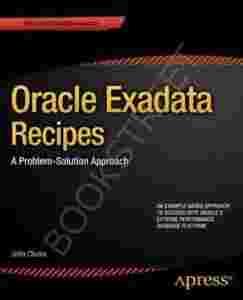Oracle Exadata Recipes takes an
example-based, problem/solution approach in showing how
to size, install, configure, manage, monitor, optimize,
and migrate Oracle database workloads on and to the
Oracle Exadata Database Machine. Whether you’re an
Oracle Database administrator, Unix/Linux administrator,
storage administrator, network administrator, or Oracle
developer,
Oracle Exadata Recipes provides
effective and proven solutions to accomplish a wide
variety of tasks on the Exadata Database Machine.
You can feel confident using the reliable solutions that
are demonstrated in this book in your enterprise Exadata
environment.
Managing Oracle Exadata is
unlike managing a traditional Oracle database. Oracle’s
Exadata Database Machine is a pre-configured engineered
system comprised of hardware and software, built to
deliver extreme performance for Oracle Database
workloads. Exadata delivers extreme performance by
offering an optimally balanced hardware infrastructure
with fast components at each layer of the engineered
technology stack, as well as a unique set of Oracle
software features designed to leverage the
high-performing hardware infrastructure by reducing I/O
demands. Let
Oracle Exadata Recipes help you
translate your existing Oracle Database knowledge into
the exciting new growth area that is Oracle Exadata.
- Helps extend your Oracle Database skillset to the
fast-growing, Exadata platform
- Presents information on managing Exadata in a
helpful, example-based format
- Clearly explains unique Exadata software and
hardware features
What you’ll learn
- Install and configure Exadata
- Manage your Exadata hardware infrastructure
- Monitor and troubleshoot performance issues
- Manage smart scan and cell
offload processing
- Take advantage of Hybrid Columnar
Compression
- Deploy Smart Flash Cache and Smart
Flash Logging
- Ensure the health of your Exadata environment
Who this book is for
Oracle Exadata
Recipes is for Oracle Database administrators,
Unix/Linux administrators, storage administrators,
backup administrators, network administrators, and
Oracle developers who want to quickly learn to develop
effective and proven solutions without reading through a
lengthy manual scrubbing for techniques. Readers in a
hurry will appreciate the recipe format that sets up
solutions to common tasks as the centerpiece of the
book.
Table of Contents
- Exadata Hardware
- Exadata Software
- How Oracle Works on Exadata
- Workload Qualification
- Sizing Exadata
- Preparing for Exadata
- Administration and Diagnostics Utilities
- Backup and Recovery
- Storage Administration
- Network Administration
- Patching and Upgrades
- Security
- Monitoring Exadata Storage Cells
- Host and Database Performance Monitoring
- Smart Scan and Cell Offload
- Hybrid Columnar Compression
- I/O Resource Management and Instance Caging
- Smart Flash Cache and Smart Flash Logging
- Storage Indexes
- Post-Installation Monitoring Tasks
- Post-Install Database Tasks

